Roy Mottram Likes to Review His Own Designs
The VTA ST-120 is quite the chameleon among power amplifiers. It can sing in romantic voice or with total xx-first century accuracy.
Featuring sixty watts or more per channel of tube ability, the amp's ability to run in either triode or ultra-linear mode offers more versatility than most any other amp I know of. If yous want to accept fun with that romantic tube sound while keeping the accuracy option, and then the ST-120 is for YOU!

Highlights
Vacuum Tube Audio ST-120 Tube Ability Amplifier
- Amazing soundstage
- Voicing can exist varied betwixt triode and ultra-linear way
- Voicing can be varied by tube rolling
- Surprising bass
- Retro await (both a plus and a minus)
- Compatible with some original Dynaco parts
- Quality construction
- Bachelor as a kit or as a finished product
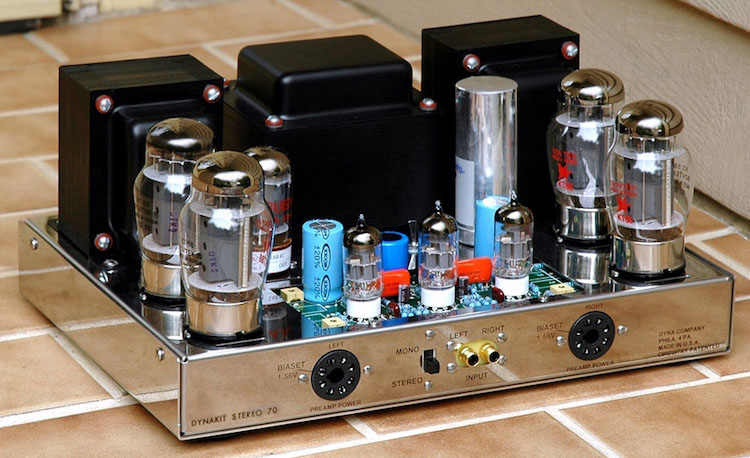
Introduction
The Vacuum Tube Audio (VTA) company is the brainchild of Mr. Bob Latino (ability amplifiers) and Mr. Roy Mottram (preamplifiers). Doing concern at the Tubes4HiFi.com website, all products are available Internet-directly. To get to the ST-120 directly, use www.tubes4hifi.com/bob.htm Based in Massachusetts (Mr. Latino) and in Puyallup, Washington (Mr. Mottram), the company sells to thousands of customers who strongly believe in American made products with TUBES.
VACUUM TUBE Sound POWER AMPLIFIER REVIEW SPECIFICATIONS
Power output:
>60 watts/channel
Inputs:
Single Pair of RCA (unbalanced) Jacks
Outputs:
R/L 5-way jacks set up to (one of) 4, 8, or xvi ohm loads (extra jacks for more impedances available on request)
THD + Noise:
1.5% at clipping
Frequency response:
20Hz-20KHz +/- 0.5dB
Power consumption:
275 watts
Recommended intermission-in time:
200 hours
Supply voltage:
120 or 240 Volts
Dimensions:
ix.5″ W x 13″ H x 6″ D
MSRP:
$929 (kit form with 6550 output tubes) to $1,580 (pre-assembled with 6550 output tubes) Other options are available
Warranty:
ane year for parts / ninety-days for tubes
SECRETS Tags:
Stereo Power Amplifier, Tube Amp, Integrated Amp, Made In United states, Tubes4hifi, Power Amplifier Reviews 2016
Links to tther Material on the Secrets Site
- jRiver Music server 22 for Mac
- WAV files ripped from CDs
- Some SACD high resolution audio discs
- Oppo BDP-105 continued via DLNA and (sometimes) used as a DAC
- Apple Airport Express as a listening room WiFi source
- iPad mini running jRemote as a system controller
- Schiit Gungnir Multibit DAC
- Emotiva BASX PT-100 preamplifier
- Tekton Pendragon speakers
- BlueJeans Cable interconnects and speaker wires
- Emotiva power conditioner
- Room treatments past ATS acoustics
- Sound (above all)
- Cost
- Parts Quality
- Durability
- Ability to change sound with different tube models or unlike brands of tubes
- Larger chassis choice with IEC ability cord
- Elimination of Dynaco slide switches & chassis layout
- Built-in bias-meter option
• Mystere pa21 Stereo Tube Power Amplifier
• PrimaLuna DiaLogue Vii Tube Monoblock Power Amplifier
By the time tubes entered their gold era (mid-1950s to mid-1970s), most of the engineering problems of producing reliable and accurate amplifiers had been solved. Gone were the days of needing an electrical engineering degree to keep your equipment running.
Instead, companies such as Dynakit and Heathkit sold do-information technology-yourself kits that allowed you to build your own audio gear from a well-idea-out, advisedly documented and easy-to-read checklist. Provided you could learn to solder and yous could read, you could build your own stereo electronics that really sounded good. OK, make that really good compared to most commercial gear available at the fourth dimension. Needless to say, these companies were household names, and their reasonably-priced kits were wildly popular.
So what happened? The one-two dial of Japanese audio and trial lawyers. When companies like Pioneer, Kenwood, Sony, Technics-by-Panasonic, and others began producing and shipping in quantity, at that place was no longer any savings do good to edifice your own gear. In addition to that, tube equipment that used 400 to 600 volts was merely considered too unsafe for consumers to have access to.
Then the great names of the DIY era faded into history. Sic Transit Gloria Mundi.
Yet here at the birth of the xx-kickoff century, the VTA company rises from the ashes resurrecting the ghosts of Dynaco and Heathkit. It's probably truthful that nigh of VTA's sales are of pre-assembled amplifiers, just if it'southward your predilection, you lot can order a kit and assemble it yourself! The disclaimers offered by the company go far clear that they're non responsible if you fry yourself while assembling the kit (aka Darwinism in action), simply if you follow the instructions, such a result is highly unlikely.
And before moving on, a quick philosophical comment about component price. Throughout virtually of my life, my discretionary budget had to exist carve up betwixt a multifariousness of family choices with the (pocket-sized) remainder used for my audio hobby. For many of those years, a thou-dollar-plus expenditure on audio gear seemed impossible. Yet in retrospect, the collection of purchases that I made and discarded could have added up (easily) to the toll of a single premium purchase that would have remained satisfying for many, many years.
So, to quote one of my parents – I was "penny-wise and pound-foolish." And I'll driblet the conclusion to this review now – I wish I had encountered the ST-120 (or another component of its quality) many years agone. And without further ado – on to the review…
Design
The chassis size and shape of the ST-120 is identical to that of the Dynaco Stereo-70 power amplifier. The advantage of this pick is that original Dynaco accessories (such as the tube cage) can still be purchased and will fit. The curse is that the clunky slide-switches and obsolete parts (the stereo/mono switch, for example) are Likewise preserved.
The original Dynaco chassis parts were made of nickel-plated steel, and few have survived the passing decades without meaning surface rust. Although the ST-120 chassis has identical dimensions, it is made of heavier guess metal (16ga VTA vs. 18ga Dynaco). Additionally, the VTA chassis uses not-magnetic stainless steel chassis plates and screws.
In improver to the upgraded chassis, the ST-120 likewise sports larger transformers than the original Dynaco amps, allowing for higher power output. These have tighter specifications than the original Dynaco transformers as well as wider bandwidth.
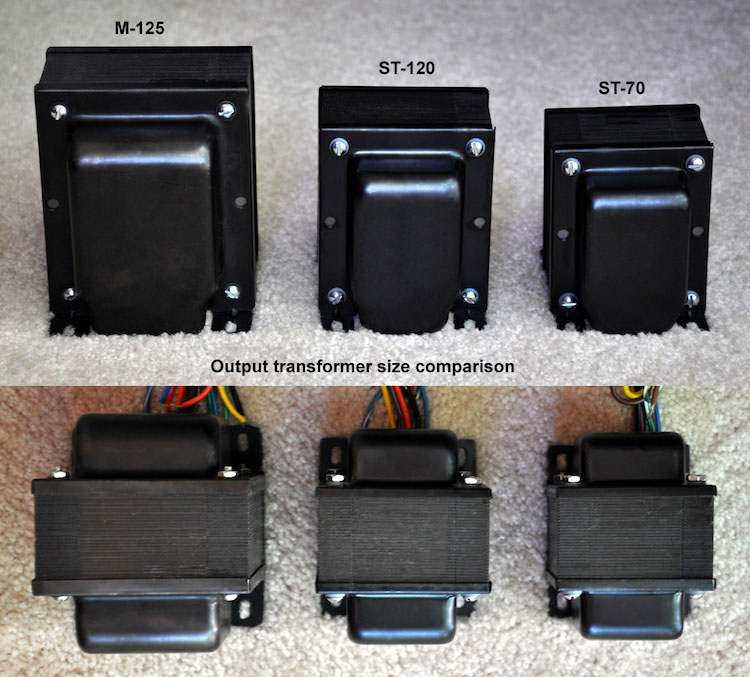
Regarding the original Dynaco ST-70, Mr. Latino says "The original driver board was made of an inexpensive phenolic material with open up solder traces on the bottom of the lath. This phenolic material was not very heat resistant and the board would many times turn black from heat under the 7199 tube sockets. The open up solder traces sometimes lifted from the lath. The carbon limerick resistors constitute on the board would, later on many years, stray from their original values."
Regarding the ST-120, Mr. Latino says "The VTA board is made of epoxy/fiberglass and has no open solder traces. Information technology has plated through holes then that parts may be placed on either the top or bottom of the board. Information technology has an on-board power supply with Nichicon depression ESR caps and an on-board bias system that allows individual biasing of each output tube. The new lath also uses 1% metal motion-picture show resistors that will non devious from their original value over the years."
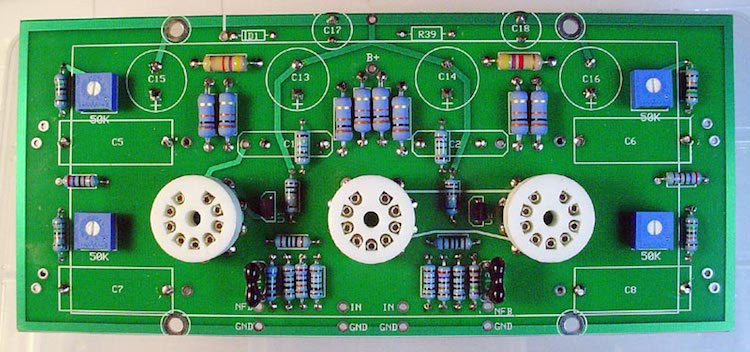
The chokes, power supply capacitors, input and output jacks and internal hookup wires are also upgraded beyond the original Dynaco specs.
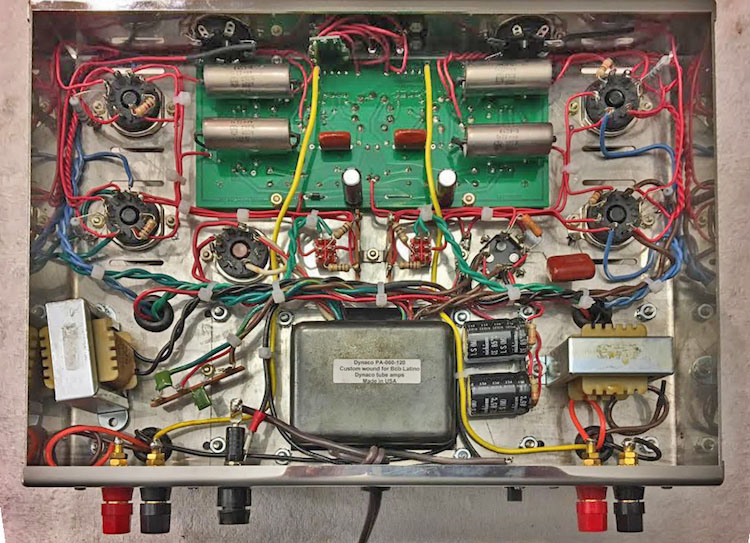
Farther, the ST-120 amp comes with switches allowing the output tubes to be run in either ultra-linear or triode mode (the latter with slightly less ultimate power output).
An optional stepped-volume attenuator tin can be added per the customer'south request that will allow control from the amplifier's front end panel. My unit was fitted with this part, although I left it at 100% and opted to command volume from a (remote-controlled) preamplifier.
Yet another choice for the ST-120 is to utilize a solid-land rectifier rather than the usual tube-type. My unit was fitted with the latter. Should you opt for the solid state rectifier, then the VTA Time Delay Relay (TDR) is recommended to allow the tube heaters to warm the tubes before B+ voltage is applied. This extends their service life.
The amp can be wired with a unmarried pair of speaker terminals set for four, 8, or 16ohm loads (your pick), or for $35 extra, whatever two of the impedance options can have separate jacks.
If you take children or curious pets in the house, and want to keep them away from the (very) hot tubes, original Dynaco tube cages tin be had from world wide web.dynakitparts.com. The cages cover the top of the amplifier, keeping hot gear away from curious hands & noses.
Equally to the blueprint philosophy, Mr. Latino stated that the goal was to create a tube amplifier (in both wired and kit grade) that would advance the circuitry and audio while correcting many of the things that the original Dynaco ST-70 amplifier received as price-cut measures.
That philosophy is both a strength and a weakness, in my stance. Keeping to the original Dynaco chassis design allows astern compatibility with the Dynaco ST-70 so that owners of those amplifiers could upgrade their rusting chassis with the new stainless steel one. Only it also keeps some of the "toll-cutting measures" including the cheap slide switches, the poor location of the ability switch on the dorsum of the chassis, and the captive (ungrounded) two-wire power cord instead of the currently-mutual IEC socket. Furthermore, the umbilical cord Dynaco sockets (on the FRONT of the chassis, that no longer serve any consummate purpose) are retained. These are not only ugly, just are likewise the only way of checking tube bias.
I'd much rather have seen a more spacious chassis. This alone would have helped with oestrus dissipation. The abysmal slide switches could have been replaced with something more modern, and even a 12V trigger socket could have been added to allow for automatic on/off functions. The tube bias functions could have been conspicuously labeled, and the obsolete Dynaco connection socket dispensed with.
Nevertheless, the amp is what it is. And many (most?) similar the design but as information technology is, thank you very much. So take my complaints with the grain of salt they deserve.
And finally, the tube complement – the iii mill-supplied tubes on the driver board are 12AU7 Sylvania tubes. These tubes strike a balance between the more sterile and authentic Genelex Gilded Lion tube sound and the more than romantic sounding Mullard tube audio. One can also choose to use the (theoretically more linear) 12BH7 tubes, simply I prefer the sound of the original 12AU7s.
Also, on the driver board, the two outermost tubes are merely phase splitters, with the actual distension done by the center tube only. So to tube coil, the center tube lone tin can be changed to get xc%-plus of the differences in sound.
Right out of the box (I bought a wired amplifier – non a kit), the amplifier sounds very, very good; excellent dynamics and tight bass with no glare at all. This amplifier tin be fitted with 6550, KT88, KT90, or KT120 output tubes (some utilize unlike bias). I've heard this amplifier with both the 6550 and the KT120 tubes. Of the ii, the KT120s accept more bass, but the 6550s accept a better treble. The review listening was performed with the (manufactory-supplied) Tung Sol 6550 output tube set up.
I found the triode style more romantic-sounding than the ultra-linear mode. In fact, with a Genelex Golden Lion tube set, and the amp in ultra-linear, I'd bet that virtually wouldn't be able to tell any difference between this amp and a proficient solid-country i. Merely the ability to change the voicing of the amp with the flip of a switch is a definite reward.
Set up
Zip much to this – plug in the tubes (they're keyed only get in i way, then you tin't mess information technology up), set the output tube bias (a multimeter & small screwdriver volition be required), hook up the speakers & inputs, turn information technology on – and instant music!
It should also be mentioned that tube amplifiers mostly produce MUCH more heat than solid-state amplifiers. Therefore, ventilation is of import. This amp should not be gear up direct on carpeting, for example, because that volition block the airflow through the chassis. So place the amplifier on a hard surface with enough of vertical clearance above.
Additional equipment used for this review included:
In Use
First, some general comments. The amplifier is dead tranquillity. Even with my ears confronting the woofers and tweeters, I could hear no hiss, hum, or noise. My speakers are very sensitive Tekton Pendragons, so if noise of whatever kind was there, I'd exist able to hear it. A quiet amplifier is indicative of skilful design – so the first impression was a reassuring 1. With burglary, I expect the sound to improve. But even when new, the amplifier is impressive-sounding.
Treble

The treble on Feed the Burn down by the Geri Allen Trio should be clean, crisp and extended. Cymbals, in particular, should exist lifelike without any sibilance or splash. And as ever, I contend that cymbals are one of the most difficult instruments for an audio system to get right. Toll is never an indicator of success on the cymbal test. Merely the ST-120 is equally skillful as I've heard.
The bells and other treble sounds in Icecream past Lou Bega should sound live. Background sounds should provide a sense of location. If the intro to this song doesn't audio like a live sidewalk recording, something's wrong! And yes, the ST-120 puts you lot there.
The opening brushed cymbal on Come Away With Me by Norah Jones should have sufficient brass and shimmer without excessive tizz. Y'all'd recall that this would be simple, merely there are a lot of amplifiers that struggle to get this right. The ST120 does.
The treble furnishings in Mala in Cuba by Mala should bound out from the mix. Too smooth? Your amp isn't doing the treble justice. Treble dynamics are preserved properly by the ST-120. Of grade, this cut is included because I like electronic music. Non to your taste? No worries!
Midrange

The unique tonality of Dolly Parton's voice on Coat of Many Colors should be immediately recognizable and unique. Her somewhat nasal tone can easily go shrill with some amplifiers, but the ST-120 avoids that anomaly.
The voices of the Eagles' Seven Bridges Road should be distinct, not just a blur. This is also a live recording, and the ambience of the crowd should testify through. A sense of infinite should abound hither, with the feeling of a wide-open outdoor stage – not an enclosed room. The midrange bloom of the ST-120 can exist exceptional (maybe its all-time attribute) depending on the recording.
The voices of Free Paw by Gentle Giant should non merely be present, but should also alloy without blurring. Each voice has its own tonality, and the amp should keep them recognizably separate, as does the ST-120.
K.D. Lang's vocalisation on Sexuality should have just a hint of breathiness to emphasize the erotic lyrics. Hearing this song on the ST-120 was enough to stir upward my single remaining hormone!
Bass

The string bass on Twisted by Joni Mitchell should be fat and (above all) should lack blur. Since bass blur is a traditional characteristic of tube amplifiers, information technology is a refreshing surprise that the ST-120 keeps the bass line crisp and tonally authentic.
The thundering bass of Dixie Craven past Little Feat should exist visceral and deep. The Grateful Dead is another ring with plenty of bass thunder. The ST-120 brings it all!
Merill Bainbridge's Mouth should have surprising and clear bass lines. This cut is a favorite of mine, and I've never heard it audio ameliorate than through the ST-120.
If Love Was a Train by Michelle Shocked should display bass dynamics equally the electric bass guitar becomes louder and softer throughout the vocal. Once again, the ST-120 keeps the bass crisp and tuneful despite the significant volume changes.
Imaging

The dynamics of Milton Hallman's pianoforte performance of Capriccio in B Minor, Opus two, No. 4 past Ernst von Dohnanyi should reveal the acoustics of the LSU Music theater. I have an reward with this recording, since I've often listened to many live recitals in that very hall. With the ST-120, you lot get a experience for the size of the original recording space.
Imagining Yous by Leah Andreone should spread various sounds well-nigh the soundstage. This is yet some other of my favorites. Leah's blatant voice should be in the room with you – non spread over a 10-foot surface area. The ST-120 (despite its power to throw an amazingly wide paradigm on need) keeps Leah's voice focused and centered.
Erich Kunzel and the Rochester Pops orchestra plays The Syncopated Clock by Leroy Anderson just wonderfully. The auditorium size should be evident from the soundstage. The orchestra should sound very large, and I'd guess that the microphones used for the recording were close within the curve of the players and on the phase. Information technology certainly sounds that way, and the ST-120 brings the sound of an orchestra in an arc to the front of your room.
Diamonds on the Soles of Her Shoes by Paul Simon should too provide a sense of movement on phase during the performance. All of Mr. Simon'south releases seem uncommonly well-recorded, and I frequently employ them to evaluate equipment. The ST-120 captures perfectly the chorus and the (separate and centered) vocalization of Mr. Simon.
Dynamics

The percussive sounds throughout Strauss's Explosions Polka should be startling. The opening cannon shot, if you're not careful, can damage your speakers (information technology IS, subsequently all, a Telarc recording). Equally the repeat of the explosions dies away, the decay should likewise be noticeable. With the ST-120, both the sharp percussive sound and the decay are clear.
Sleepwalk by Leo Kottke is a piece with a Large dynamic range. Many systems compress this or brand information technology sound similar a recording – non a real guitar in the room. The ST-120 again distinguishes itself by making this sound similar Leo is in the room with you, just only if your other components are up to the task. I preamp I used, which shall remain nameless (not the Emotiva) made this audio like a recording, not similar a real guitar in the room. But given a high-enough fidelity source, the verisimilitude of the performance shines through.
Linda Ronstadt'south Perfidia starts out softly, with just a strummed guitar and Linda'south voice. Just when the orchestra comes in, the dynamic slam should take hold of your attention. Few amplifiers (tube or solid-country) get this right, just the ST-120 does. I've yet to make up one's mind why. With some amps the sound just gets louder, while with others, the transition to total orchestra is simply phenomenal. I've heard only i other amp that did this transition better than the ST-120. And, since I know that someone's bound to ask "what was the other amp?" I'll tell you upward front that it was (surprisingly) a Luxman 1070 stereo receiver! Why that unit of measurement had the dynamics it did, I'll never know – Just I'k really sorry that I sold it!
Bye Farewell Blackbird by Luther Kent should ship you to a New Orleans Bourbon Street jazz social club. If it doesn't, something'south incorrect (but that something ISN'T the ST-120). Brash, sassy, and with some very loud sax and vocal piece of work, this cut volition give whatever amplifier a conditioning.
On The Demote
Since I accept no electronic test equipment other than a multi-meter, I could not measure or verify the specifications. I will comment, however, that the distortion specification quoted by the manufacturer (one.5%) is the baloney at the clipping point (total ability) and the amp runs at a much lower number throughout its functional range.
With the high-quality parts in the ST-120, I'd expect very good reliability. The VTA company has now been in business organisation for 10-years and honors its warranties. Google the company for a feel of the current customers' comments.
Conclusions
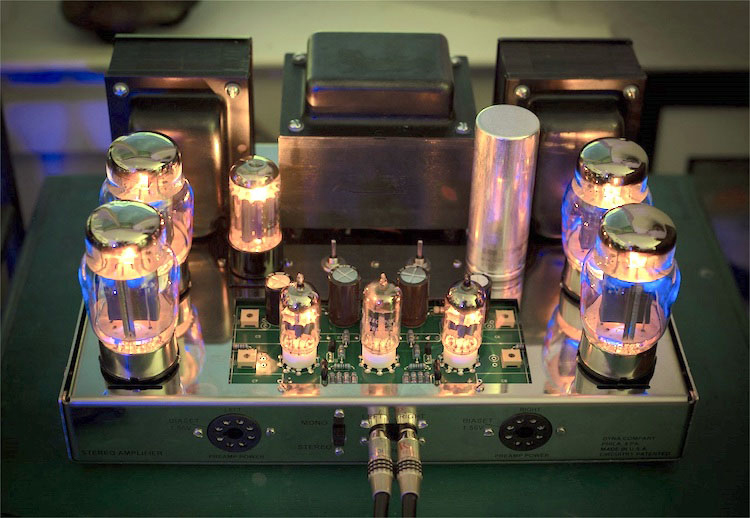
THE VTA ST-120 Power AMPLIFIER is a Bargain in its Wired Form and an Unbelievable Bargain in its Kit Class. If You lot're Looking for an American-made Tube Amplifier of Corking Quality and Sound, You Volition Not do Amend.
Likes
Would Similar To Encounter
What tin I say? There are few other American-made tube amplifiers at the cost of the VTA ST-120. The closest I can recollect of are the Audio by Van Alstine Ultravalve ($1,500 @ only 35wpc) and the Rogue Cronus Magnum (a fully-tubed integrated amp at twice the price of this unit of measurement). Of course, when you add together the cost of a good preamplifier to the price of the VTA ST-120, the Rogue may become more competitive.
Yous can get Chinese-made amplifiers for the price of this ST-120. But those tube ability amps contain parts that don't fifty-fifty arroyo the quality of those in the ST-120. In terms of ultimate value, I believe that the ST-120 is absolutely amazing.
What a nice amplifier! I plan to keep this ane. Its 60-watts plus per aqueduct (and that's with the modest 6550 tubes!) is more than sufficient for my speakers, and the tube soundstage is to die for. Any equivalent amplifier from Audio Enquiry, McIntosh or Conrad-Johnson would toll far, far more. Do yourself a favor – If yous recall you lot might be in the marketplace for a tube power amp, put this one on your curt list. You lot won't regret it.
Glenn Young
Source: https://hometheaterhifi.com/reviews/amplifier/power-amplifier/vacuum-tube-audio-st-120-tube-power-amplifier-review/
Belum ada Komentar untuk "Roy Mottram Likes to Review His Own Designs"
Posting Komentar